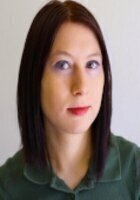All Common Core: High School - Geometry Resources
Example Questions
Example Question #51 : Geometric Measurement & Dimension
Given a cylinder with radius 

The first step is see what the cross section parallel to the base looks like.
Since we are dealing with a cylinder, the cross section that we are dealing with parallel to the base is a circle.
So all we need to do is recall the area of a circle equation, and substitute the radius given for 
Now we round our answer to the nearest tenth
Example Question #12 : Identify Shapes In 2 D Cross Sections And Rotations In 3 D: Ccss.Math.Content.Hsg Gmd.B.4
Given a sphere with a volume of 
The first step is to recall the volume equation of a sphere.
Since we are given the volume, we can plug it in for V
Since we want to find the area of the perpendicular cross section, we need to find what the radius is.
Now we solve for r
Now we can use the radius we found to find the area of the cross section.
The cross section in this case is a circle, so now we will use the area of a circle formula, which is
Now we simply substitute the radius we just found for 
Now we round our answer to the nearest tenth, which is
Example Question #61 : Geometric Measurement & Dimension
What is the resulting image when you rotate Triangle ABC around the point C?







When you rotate a triangle around one of its points, the resulting image is a cone. The following image helps illustrate this:

All Common Core: High School - Geometry Resources















![\\\frac{10275}{2} = \pi r^{3} \\\\\frac{10275}{2 \pi} = r^{3} \\r=\sqrt[3]{ \frac{10275}{2 \pi} }](https://vt-vtwa-assets.varsitytutors.com/vt-vtwa/uploads/formula_image/image/1052387/gif.latex)






